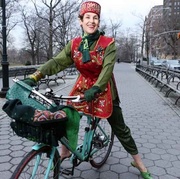
V
intage can be intimidating. It’s certainly not as simple as going to the mall, finding your size, and buying a mass-produced outfit. You have to dig through racks and racks of wildly diverse items, with mysterious sizing, looking for the piece that just feels right. But vintage has a lot going for it: The clothing is greener, because it was not manufactured overseas; the materials and stitching are usually top-notch; and the prices are far lower than those of modern clothing of the same quality. And you can’t beat it when it comes to achieving a one-of-a-kind retro look.
“Vintage clothing is the church of the individual dresser.”
The question is: How exactly can you make vintage clothes work for you? That’s where stylists like Naomi Thompson come in. She offers a dressing service, where she takes a client out to tea, speaks with her about her personal style, and then helps her find vintage pieces that fit her body, budget, and image. Thompson’s got a lot of cred, as she’s a part of a swinging vintage scene in London that’s produced several well-regarded vintage fashion blogs including her own Vintage Secret, Fleur de Guerre’s Diary of a Vintage Girl, and Jeni Yesterday’s Yesterday Girl.

Partygoers enjoy tea and vintage at one of Naomi Thompson’s dressing events. Via the Vintage Secret Facebook page.
For those of us stateside who can’t afford to hop on a plane to the United Kindgom for a little vintage therapy, Thompson published Style Me Vintage—Clothes: A Guide to Sourcing and Creating Retro Looks this summer. The book is part of a three-volume series that includes a guide on retro hair by Belinda Hay and a guide to re-creating classic makeup techniques by Katie Reynolds. We reached out to Thompson and asked her share some of her best pointers for making vintage wearable and fun.
Collectors Weekly: How did you first get into vintage clothing?

Naomi Thompson, at right, helps to turn an old shop called The Parlour into a pop-up vintage styling boutique. Via the Vintage Secret Facebook page.
Naomi Thompson: Vintage clothing was always the magic that filled my grandmother’s house. She had been an avid textiles collector for 40 years and I grew up going through wardrobes, trunks, and hat boxes. As I got older I realized I fit into a lot of it. I love the creativity that comes with dressing, so it was the perfect medium for me.
My career in vintage started with my [now-defunct] online store, one of the first high-tech and glossy sites that sold vintage. I wanted the clothes to talk for themselves, so I had them professionally shot, and they rotated in 3D. I found it odd that no one had done that yet.
Collectors Weekly: How did you transition to personal stylist?

Accessories at one of Thompson’s dressing events. Via the Vintage Secret Facebook page.
Thompson: I had to tame my own buying addiction, so I decided to teach others to shop. I had also dressed people for years prior to that, and developed a very quick eye when it came to vintage cuts on modern bodies. My book, Style Me Vintage—Clothes, came about from my blog. The publishers had read it, and liked my writing style. I’m also one of the few vintage aficionados that genuinely loves good clothing from all eras.
Collectors Weekly: What is a day with you like?

In the dressing room, Thompson styles a partygoer at Tweed, a nostalgic event at the White Blackbird country house. Via the Vintage Secret Facebook page.
Thompson: A day with me lasts on average 5-6 hours. People spend varying amounts but I reckon that the average is probably £300 [around $500]. For that, I would expect to find them 8 to 10 very good wearable pieces. I’m not interested in encouraging people to buy garments that are priced higher than their market value. With me, it’s all about learning about vintage, learning about your shape, and finding a whole hoard of bargains in the process.
I have dressed lots of singers, which is great fun. My faves have been Bishi and Gabby Young, of Gabby Young and Other Animals. I like pushing the boundaries of clothing, and figuring out what someone is going to wear on stage or for a music video takes it to a new dimension.
Collectors Weekly: Why do you think vintage is so popular now?

In a ’60s dress, Thompson is ready to help people find the perfect hat at her Parlour pop-up shop. Via the Vintage Secret Facebook page.
Thompson: People have woken up to the fact that it retains its value, which, with good care, can even increase despite gentle wear. You just don’t get that kind of value for money on the High Street anymore. Plus there is also the unique factor. Vintage clothing is the church of the individual dresser.
Collectors Weekly: What do you say to people who feel intimidated by vintage?

Thompson helps the frontwoman of Gabby Young and Other Animals adjust the fit of a top. Via Gabby Young’s Style Blog.
Thompson: It’s like a language. Once you start to understand how cuts, shapes, and fabrics sit on your own body, then the process is demystified. I’ve dressed ladies of all ages, shapes, and sizes. I once had four clients in a row who were older than 60, and the largest size I have found vintage for is a UK 22 [size 18 in the United States]. Knowing the right fit comes with training your eye. You need to have a good understanding of vintage cuts, and ideally, a few years behind you of dressing women.
Learning about quality is also very important. A good cut or a pattern often jumps out as being top-quality stock. For a beginner, it’s all about shopping with your hands. You get a great indication of quality from the touch and weight of a garment.
Collectors Weekly: How do you build a vintage look?

Young tries out a wide range of looks, from country cutie to city sophisticate. Via Gabby Young’s Style Blog.
Thompson: I recommend starting with a trip to What Katie Did (available in both the US and the UK) if you want some really good, period-specific shapewear. I’m also a fan of your average pair of Spanx panties. Getting your stockings or tights right is also a must. For a more modern look, I like wearing a vintage dress with very bright modern tights.
I don’t actually subscribe to the notion that one era suits a body type. Women’s body shapes didn’t change each decade, their undergarments did, in line with the cuts and fashions of the time. For instance, I believe everyone has a waist and, therefore, can wear a nice ’50s dress. It’s about getting the correct fit no matter what era.
Collectors Weekly: What are other ways to mix vintage items with modern clothing?

Thompson helps a woman pick out vintage dresses at the Parlour. Via the Vintage Secret Facebook page.
“Yes, there is some bad vintage, but on the whole it’s not whiffy or unwearable.”
Thompson: You can be very fashion-forward wearing vintage. I love dramatic old jackets with new slim jeans. I had a great collection of Victorian and Edwardian ones that looked fabulously dark and decadent, and the cuts were exquisite. Whether you can get away with wearing vintage in the office really depends where you work. I spent a while working in the conservative finance industry and didn’t find it hard to sneak in well-cut vintage little black dresses.
Accessories are versatile. You can find period-accurate ones to complete an exact era-specific look, or you can dress up a modern look with vintage, or tone down a vintage outfit with modern accessories. They can also be wonderfully cheap. My fave place in the world for accessories is The Shop on Cheshire Street just off London’s Brick Lane. And be selective about shoes: Bad shoes always break a look.
Collectors Weekly: How do you get your clients to step out of their comfort zones?

Thompson on a road trip with Fleur de Guerre, from Diary of a Vintage Girl. Via Vintage Secret.
Thompson: A lot of cajoling and gentle nudging. It works every time, and if I had a pound each time someone was greatly surprised I would have retired a long time ago. My ethos is more about dressing people in good quality vintage items that suit their shape, rather than dressing by era. I believe you can get quality, iconic items from any decade.
Collectors Weekly: What is a good price range for a vintage dress?
Thompson: That’s a bit like asking how long is a piece of string. It varies enormously. The fluctuation is oddly based on where you buy the item. It’s important to know the dealers and shops in the your area. A lot of buying and selling is contact-based.
Collectors Weekly: What are the biggest misconceptions about vintage?

Thompson wears a ’50s dress for the Liberty floral flash mob in London. Via Style Bubble.
Thompson: That it smells, and that it will fall apart. Yes, there is some bad vintage, but on the whole it’s not whiffy or unwearable. To remove a stale sweat smell, just spray cheap vodka, neat, from a spritzer bottle. It acts like dry-cleaning fluid. I also like to hang garments outside in a breeze for a day, though not in bright sun.
Keep it out of sunlight! That’s my Number One. And keep it clean; moths eat dirty clothes. Anything made out of cotton is a good bet. I’m sure this is why the ’50s trend is still in full swing. The skirts and dresses are still wearable and easy to care for.
Collectors Weekly: How do you spot fakes?

Thompson, right, selects clothes for Young to try out. Via Gabby Young’s Style Blog.
Thompson: Swot up about labels. A good study tool for this is the Vintage Fashion Guild’s Label Resource. The labels tell you nothing about the size, but knowing your designers, even if they don’t make clothes anymore, is essential if you are going to collect clothing. I look at the stitching and the fastenings to date a piece.
Collectors Weekly: Do you think modern clothes done in a vintage style are acceptable when it comes to creating a look?
Thompson: I used to be quite purist on this subject but now I do believe that it is acceptable. There are so many good repro companies out there now such as Heyday Online, Tara Starlet, and Freddies of Pinewood (who make the best repro denim out there). My tip for vintage swimwear is don’t wear it in the water. Buy repro, and keep the real deal for posing for photo shoots.

Thompson’s book, “Style Me Vintage—Clothes,” features Jeni Yesterday on the cover.
Learn more about Naomi Thompson at her web site, Vintage Secret, or her Facebook page. See more of Gabby Young’s looks at her style blog.

 Leading the Charge Against Casual Style, Armed With Antique Clothes and a Bike
Leading the Charge Against Casual Style, Armed With Antique Clothes and a Bike
 Va-Va-Voom Vintage: Dita Von Teese on Burlesque, Cars, and Lingerie
Va-Va-Voom Vintage: Dita Von Teese on Burlesque, Cars, and Lingerie Leading the Charge Against Casual Style, Armed With Antique Clothes and a Bike
Leading the Charge Against Casual Style, Armed With Antique Clothes and a Bike Hidden Gems: Lost Hollywood Jewelry Trove Uncovered in Burbank Warehouse
Hidden Gems: Lost Hollywood Jewelry Trove Uncovered in Burbank Warehouse Womens Clothing“Clothes make the man,” said Mark Twain. “Naked people have little or no in…
Womens Clothing“Clothes make the man,” said Mark Twain. “Naked people have little or no in… Mari Tepper: Laying it on the Line
Mari Tepper: Laying it on the Line Nice Ice: Valerie Hammond on the Genteel Charm of Vintage Canadian Costume Jewelry
Nice Ice: Valerie Hammond on the Genteel Charm of Vintage Canadian Costume Jewelry How Jim Heimann Got Crazy for California Architecture
How Jim Heimann Got Crazy for California Architecture Modernist Man: Jock Peters May Be the Most Influential Architect You've Never Heard Of
Modernist Man: Jock Peters May Be the Most Influential Architect You've Never Heard Of Meet Cute: Were Kokeshi Dolls the Models for Hello Kitty, Pokemon, and Be@rbrick?
Meet Cute: Were Kokeshi Dolls the Models for Hello Kitty, Pokemon, and Be@rbrick? When the King of Comedy Posters Set His Surreal Sights on the World of Rock 'n' Roll
When the King of Comedy Posters Set His Surreal Sights on the World of Rock 'n' Roll How One Artist Makes New Art From Old Coloring Books and Found Photos
How One Artist Makes New Art From Old Coloring Books and Found Photos Say Cheese! How Bad Photography Has Changed Our Definition of Good Pictures
Say Cheese! How Bad Photography Has Changed Our Definition of Good Pictures Middle Earthenware: One Family's Quest to Reclaim Its Place in British Pottery History
Middle Earthenware: One Family's Quest to Reclaim Its Place in British Pottery History Fancy Fowl: How an Evil Sea Captain and a Beloved Queen Made the World Crave KFC
Fancy Fowl: How an Evil Sea Captain and a Beloved Queen Made the World Crave KFC
Great advice, Naomi really knows her stuff :)